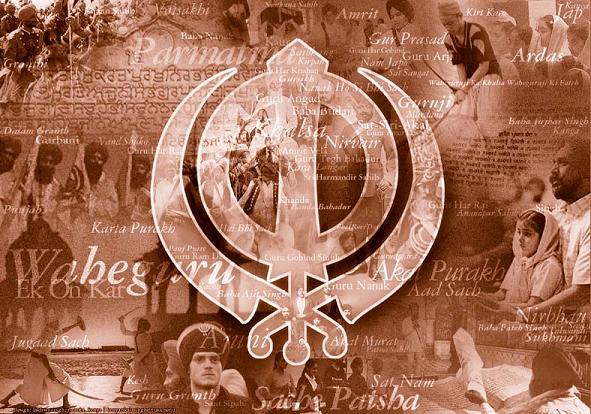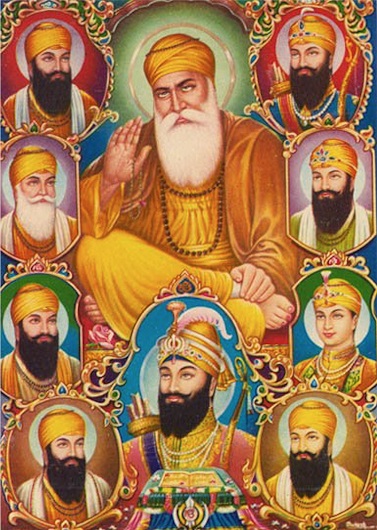Mata Kishan Kaur Kaonke
This is the sakhi of a brave woman who lived in this century and whose life was devoted to the Sikh Panth. She was born in 1856 and was the daughter of Sardar Suba Singh of Village Lohgarh in Ludhiana district. While living in her village, she learned Gurbani and Sikh history from the granthi ji of the Gurdwara there. She was married to Sardar Harnam Singh of Village Kaonke. He later on joined the army and died in 1902 while serving in Burma. Her two sons had also died when they were still young. She was thus left a widow and without any offspring. Rather than bearing the curses of Hindu society of being a widow or feeling lonely, she decided to spend the rest of her life in the service of the Khalsa Panth.
In 1903, Mata Kishan Kaur went to Gurdwara Sach Khand, Nanded in the south of India. The Gurdwara was built in the memory of Guru Gobind Singh who left for his heavenly abode from there. She stayed at Nanded for some time, took Amrit to become a saint-soldier of the Khalsa Panth and started tying a turban on her head. She devoted herself to organizing people to preach and practice the equality of men and women and the so-called low castes and high castes of Hindu society.
After the death of her husband, his brother did not let her take possession of her share of the land. When other methods failed, she went to the fields and personally told the brother of her husband to leave the fields for her. Finding her alone and helpless in the fields, he made some vulgar jokes and did not leave the fields. She was courageous and a brave person. She raised her strong arm and fixed a hard slap on his face. The man, feeling guilty of his misbehavior and being hit hard by an upright woman ran away to avoid a second slap from her. Mata Kaonke took over the land which belonged to her. She was respected by the whole village as a great lady of good behavior, with great courage.
When the Khalsa Panth started the Gurdwara Freedom Movement in the beginning of the 20th century, she joined the movement as an active worker. In 1920, the Mahants refused offerings of some Sikhs who were recent converts from the so-called low-castes. She was with the Sikhs who went to the Golden Temple to protest against this anti-Sikh behavior of the Mahants. She was there to physically set the Mahants straight if they did not listen to their arguments. Observing the mood of the Sikhs, the Mahants fled from the Gurdwara leaving it vacant for the Sikhs to occupy and take over its control.
In September 1922, during Guru Ka Bagh Morcha, Sikhs were beaten by police and even run over by the mounted police, breaking the bones of Sikhs under the hooves of horses. Mata Ji and her associates undertook the sewa of caring for the injured Sikhs, taking them to the hospitals, and nursing them there. Every day she would go with the jatha to the Guru Ka Bagh. The policemen would beat the Sikhs with lathis to stop them from going to the Bagh. The police would let the attending Sikhs carry away the injured members of the protesting jatha. It is then that Mai Kishan Kaur took over the duty of administering first aid to them and taking them to the hospital.
One day, a very large number of Sikhs suffered very severe injuries. The police chief taunted her by telling her that there was much sewa for her to do. Mata Ji was already feeling very much hurt to see the Sikhs being tortured and beaten like that. After hearing the taunting words of the police chief, she could no longer restrain herself. In response to his comments, she took a few firm daring steps towards the police chief, and looking at him with ferocious eyes, she raised her arm and like a lightning bolt, hit him in the face.
The strong unexpected slap shook the police chief and turned his face over his shoulder. Without giving the brave woman a second look, he ran towards his tent to save his face from the second slap. This was a great insult not only for all of the police force, but for the whole British government.
Hearing of the tortures committed on the innocent Sikhs and the bearing of atrocities by them, Father C.F. Andrews, a Christian missionary, decided to come to Guru Ka Bagh. After seeing the anti-human behavior of the British police officers, he cried, "I see hundreds of Christs being crucified every day by the Christians themselves." This changed the direction of the Morcha and finally the government yielded to permit the Sikhs their legal rights by owning the Guru Ka Bagh lands.
Mata Kaonke again performed a daring deed during Jaito Morcha. Sikhs wanted to continue the Akhand Path disrupted by the police by arresting all the Sikhs there. A jatha of 500 Sikhs marched from the Akal Takhat in Amritsar to Gurdwara Jaito. People knew the jatha would be handled brutally by the police. To know the truth and details of the brutalities Mata Kaonke dressed herself as a Jain woman and moved into the police camp. The government forces rained bullets on the jatha. The police secretly disposed of the dead bodies and removed the injured to the hospitals. They issued totally misleading reports and did not give correct information about the Sikhs killed and injured. Mata Kaonke had seen all the actions with her own eyes and she made the facts public. When the details revealed by her were found to be true, the government was very much embarrassed, and was also very much surprised. After some time the secret police traced her and charged her with espionage. She was sentenced to four years in jail.
In 1925, the government accepted their defeat in the struggle against the Sikhs. They agreed to the formation of a Sikh body which would take over the management of the Gurdwaras from the Mahants who were under the control of the government. With this agreement, all the persons arrested in connection with the Gurdwara movement were released. Mata Kaonke, however, had to remain in jail until 1928 to undergo her full sentence.
When released from jail, she went straight to the Akal Takhat to express her thanks to the Guru for giving her a chance to serve the Khalsa Panth. She suffered for the cause of the Sikhs and the freedom of the Gurdwaras from government control. The Khalsa Panth honored her at the Akal Takhat and gave her the title of Mata. Since then she became popular as Mata Kishan Kaur.
During the rest of her life, she stayed at her village, built a Gurdwara there and preached the Sikh faith to the people in the region. She died at the age of 96 in 1952.
The life spent in the service of society is fruitful. Sikh women can accomplish this by overcoming their family limitations.

